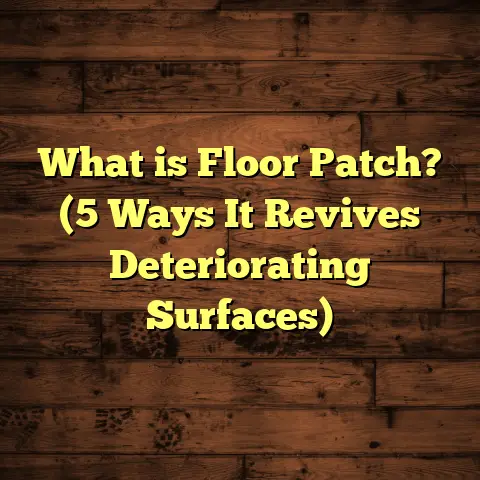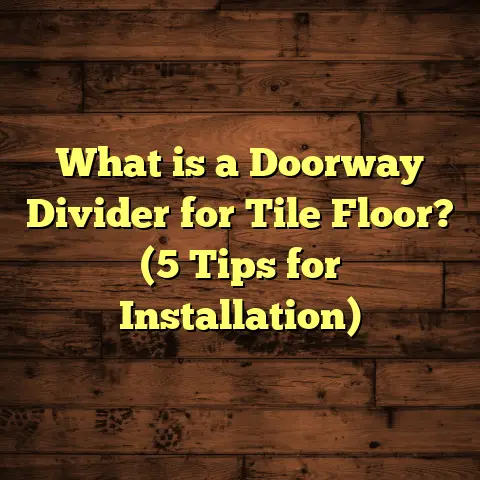What is 5 Floor Moisture Reading? (5 Tips for Accurate Testing)
What is 5 Floor Moisture Reading?
When I first started installing floors over a decade ago, moisture was something I didn’t pay enough attention to. I thought, “How wet can the floor really be?” But after dealing with warped hardwood, bubbling vinyl, and even mold issues under laminate, I quickly realized moisture testing isn’t just important—it’s absolutely necessary.
The “5 floor moisture reading” is a technique I use on every flooring project to avoid these problems. It means taking moisture readings at five different locations across the floor before installation. Sounds simple, but this process can literally save thousands of dollars and weeks of frustration.
So, what exactly is a 5 floor moisture reading? It’s a method where I measure moisture levels at five critical points on the subfloor: usually the four corners plus the center of the room. This gives me a detailed snapshot of how moisture is distributed beneath the surface. If even one spot is problematic, it could affect the entire floor’s performance.
Let me walk you through everything I’ve learned about this over years of experience, including how to do it right, why it matters, and how it saves homeowners from costly future headaches.
Why Should You Care About Floor Moisture?
Before jumping into the testing process, you might ask: why does floor moisture matter so much? Can’t the flooring materials handle some dampness?
The answer is no. Excess moisture is one of the biggest enemies of flooring. Whether you have hardwood, laminate, vinyl, or tile, moisture can cause:
- Warping and cupping: Wood absorbs moisture and swells unevenly, causing boards to bend.
- Bubbling and peeling: Vinyl and laminate layers lift when trapped moisture pushes up.
- Mold and mildew growth: Damp environments under floors are breeding grounds for harmful fungi.
- Adhesive failure: Moisture prevents glue or adhesives from bonding properly.
- Structural damage: Prolonged moisture exposure can weaken subfloor materials.
For example, hardwood floors generally require subfloor moisture content to be below 12%. Concrete slabs should have moisture emission rates below 3-4 pounds per 1,000 square feet over 24 hours (measured by calcium chloride tests).
If you skip testing or ignore these limits, you’re gambling with your investment.
My Early Learning Curve with Moisture Issues
I remember one job early in my career where I installed a beautiful oak floor in a new home in Ohio. The concrete slab was only a few weeks old—I thought it was ready. No moisture test was done.
Within three months, the floor started cupping badly in multiple spots. The client was frustrated, and honestly, so was I. We had to pull up a large section of flooring and redo it after drying out the slab for months.
That experience taught me a hard lesson: never assume anything about moisture levels without testing. Since then, I’ve adopted the 5-point moisture reading as a non-negotiable step.
How Does the 5 Floor Moisture Reading Work?
Step 1: Selecting the Five Testing Points
The logic behind five points is simple: moisture isn’t evenly spread across floors. You could have a dry corner and a soaking wet center.
I start by dividing the floor into four quadrants and pick one spot in each corner plus one in the middle. This covers most variations in moisture levels.
Step 2: Preparing the Testing Surface
Cleaning debris and dust from the subfloor before testing ensures accurate readings. Dirt or debris can affect meter contact or calcium chloride results.
Step 3: Using Appropriate Tools
Depending on the subfloor type—wood or concrete—I use different tools:
- Wood subfloors: I use a pin-type or pinless moisture meter that measures electrical resistance or capacitance changes caused by water content in wood fibers.
- Concrete slabs: Since meters aren’t reliable on concrete surfaces, I prefer calcium chloride tests or relative humidity probes inserted into drilled holes.
Step 4: Taking Measurements
At each of the five points:
- For wood, I insert pins into the wood or hold pinless meters flat on the surface.
- For concrete with calcium chloride testing, I place a small dish of calcium chloride powder sealed under plastic for 60-72 hours, then measure absorbed moisture.
- For relative humidity probes, I set them in place for a few hours to days depending on conditions.
Step 5: Recording and Analyzing Data
I record readings carefully with time stamps and exact locations. Then I compare them to industry standards like ASTM F2170 for RH probes or ASTM F1869 for calcium chloride tests.
If any point exceeds safe moisture limits (e.g., concrete RH above 75%, calcium chloride >3 lbs/1000 sq ft), I recommend remedial actions before installation.
Why Five Points Are Better Than One or Two
I often get asked why not just test one or two spots? The reality is moisture can vary dramatically. In one job in Minnesota, a single test in one corner showed safe levels—below 4%. But when I tested five points across a 500-square-foot basement slab, two points near an exterior wall spiked at 7%.
Had I relied on just one test, we’d be installing flooring over an undetected problem area. That would cause failure in those spots later.
Five-point testing gives a much more reliable picture and reduces risk of surprises.
Typical Moisture Measurements and Costs
Here’s what I usually see from projects across different regions:
| Subfloor Type | Typical Moisture Range | Acceptable Limit | Approximate Cost for Testing (per room) |
|---|---|---|---|
| Concrete slab | 3% to 6% (calcium chloride) | ≤4% (calcium chloride test) | $100 – $250 |
| Wood subfloor | 6% to 14% (moisture meter) | ≤12% | $50 – $125 |
Testing costs vary based on size, complexity, and test type. For example, calcium chloride kits cost about $50 each plus labor time but are very accurate for concrete slabs.
The Science Behind Moisture Readings
Why Moisture Meters Work Differently on Various Materials
Moisture meters function by sending electrical signals through material. Wet materials conduct electricity better than dry ones.
- Wood: Because of its porous cellular structure, wood’s electrical resistance changes predictably with moisture content.
- Concrete: Highly dense and less porous than wood; readings are less reliable with meters alone.
Hence why ASTM standards recommend calcium chloride tests or RH probes for concrete slabs.
Understanding Moisture Emission Rates (Calcium Chloride Test)
This test measures how many pounds of water vapor pass through 1,000 square feet of concrete in 24 hours.
For example:
- A reading of 3 pounds means moderate moisture but usually acceptable for many flooring types.
- Above 5 pounds signals high moisture risk needing mitigation.
Case Study: Basement Flooring Saved by 5-Point Testing
A homeowner in Chicago wanted hardwood floors installed in their basement. Before starting, I performed my standard five-point testing using calcium chloride kits.
Three points near exterior walls showed readings between 5.5 and 6 pounds per 1000 sq ft/24 hrs — above recommended limits.
I advised holding off installation and installing industrial dehumidifiers plus improved drainage outside.
After three weeks of drying and retesting, readings dropped below 3 pounds per square foot. We installed engineered hardwood with a vapor barrier underneath.
Six months later, the floor remained flawless with no signs of warping or mold.
Without those five data points early on, this project could have been a disaster costing thousands more to fix.
5 Tips for Accurate Floor Moisture Testing
Here are five practical tips from my own fieldwork that help make sure your readings are trustworthy:
Tip 1: Test Multiple Points—Never Just One
Moisture can hide in pockets. Testing multiple points gives you confidence about overall conditions.
Tip 2: Choose Tools Based on Subfloor
Using wood meters on concrete is unreliable; calcium chloride tests give accuracy but take longer. Pick tools smartly.
Tip 3: Time Your Tests Right
Don’t test immediately after rainstorms or concrete pours. Wait several days or weeks for conditions to stabilize.
Tip 4: Document Everything
Keep detailed notes on where and when tests were done. It helps if problems arise later or for warranty claims.
Tip 5: Retest After Drying Measures
If initial readings are high and you take drying steps (like dehumidifiers), always retest before installing floors.
Common Questions About Floor Moisture Readings
Q: How long does testing take?
A: Simple meter readings take minutes per spot. Calcium chloride tests require sealing dishes for 48-72 hours plus lab analysis time.
Q: Can I do this myself?
A: Yes, with some basic tools like an inexpensive pinless meter or DIY calcium chloride kits. But professional experience helps interpret results accurately.
Q: What happens if moisture is too high?
A: You can delay installation while drying out floors using dehumidifiers or fans. Sometimes vapor barriers or special adhesives are needed.
Personal Stories from the Field
One winter job in Vermont involved installing luxury vinyl planks over a concrete slab. The owner was eager to finish quickly but agreed to my five-point test first.
Two points near basement stairs showed elevated moisture levels around 6%. A quick fix involved adding a heavy-duty vapor barrier beneath the vinyl plus running dehumidifiers for two weeks.
The owner later told me he appreciated not rushing because his floors still look perfect three years later without any issues.
Another memorable case was a large commercial project where skipping thorough testing led to massive flooring failure within months—a costly lesson for all involved.
How Moisture Affects Different Flooring Types
Here’s a quick breakdown:
| Flooring Type | Moisture Sensitivity | Consequences of High Moisture |
|---|---|---|
| Hardwood | Very sensitive | Warping, cupping, mold |
| Engineered hardwood | Moderate sensitivity | Edge swelling, delamination |
| Laminate | Sensitive | Peeling edges, swelling |
| Vinyl | Moderate sensitivity | Bubbling, adhesive failure |
| Tile | Low sensitivity | Grout cracking if subfloor moves due to water |
Knowing your flooring type helps tailor your moisture testing strategy.
Regional Differences Affecting Moisture Levels
Humidity and climate greatly affect how floors dry out:
- Humid regions (Florida, Gulf Coast): Concrete slabs stay damp longer; extra care needed.
- Cold climates (Minnesota, Vermont): Freeze-thaw cycles cause slab cracking; more testing needed.
- Dry climates (Arizona, Nevada): Faster drying but seasonal humidity spikes possible indoors.
I always adapt my testing schedule based on local weather patterns.
How Much Does Ignoring Moisture Testing Cost?
Here’s a rough breakdown based on my project history:
| Problem | Estimated Repair Cost | Time Required |
|---|---|---|
| Hardwood warping | $5,000 – $15,000 | Weeks to months |
| Mold remediation | $3,000 – $10,000 | Days to weeks |
| Vinyl bubbling | $1,500 – $4,000 | Days |
| Tile grout repair | $1,000 – $3,000 | Days |
These costs often outweigh the $50-$250 investment in proper moisture testing by a huge margin.
Final Thoughts on Getting Your Floor Right From Day One
Having installed hundreds of floors over my career—from tiny apartments to large commercial spaces—I can’t stress enough how crucial it is to take moisture seriously before installation. The five-point moisture reading is simple but powerful: it catches hidden issues early and helps plan for success.
If you’re planning new flooring soon—whether yourself or with contractors—ask about their moisture testing process. If they skip it or only test one spot? That’s a red flag.
Moisture testing might not be glamorous but it’s like insurance for your floor’s future. Trust me—once you’ve seen what ignoring it costs in repairs and headaches, you’ll never skip this step again.
Have any questions about how to do this yourself? Or want tips on what tools work best? Just ask—I’m here to share everything from my years on the job!
This completes your comprehensive guide on what a 5 floor moisture reading is and how to do it right with practical tips backed by data and experience. If you want me to expand on any part further or add specific regional advice or tool recommendations just let me know!





